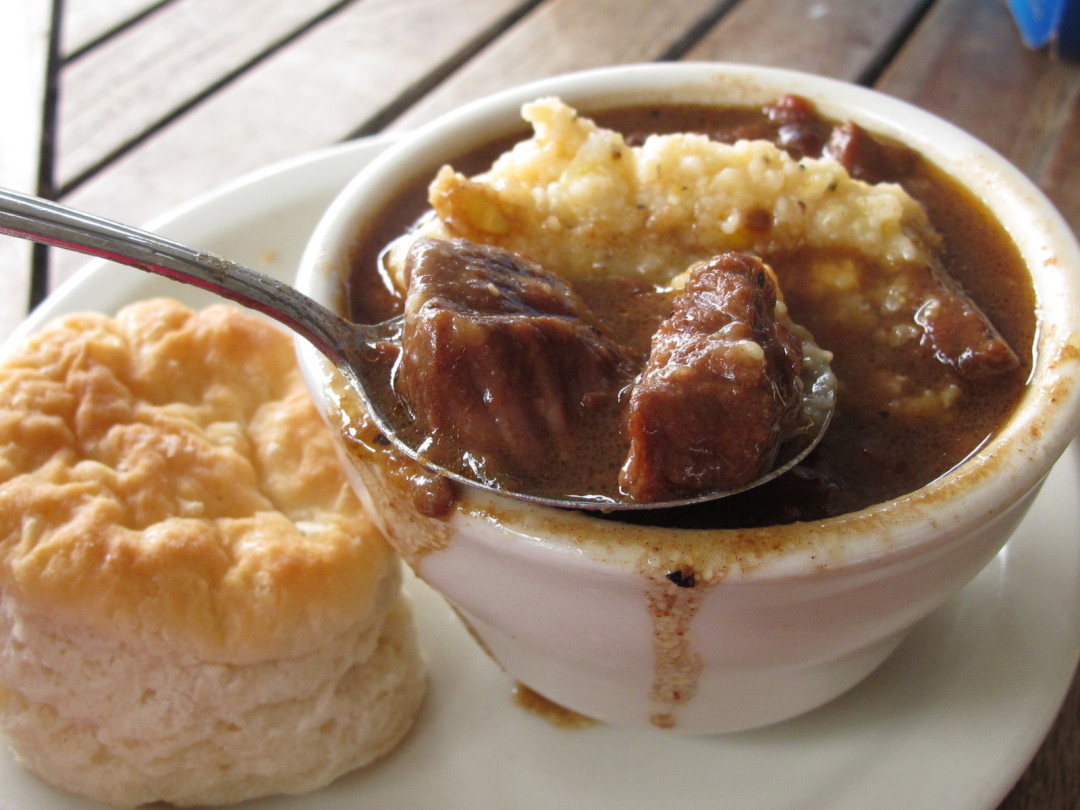Grillades and Grits

Grillades and grits at BB's on White Oak
The grillades (pronounced GREE-yads) that appeared in cookbooks in the late 1800s were boneless medallions of veal simmered in gravy. Of course, veal was rather loosely defined in that era. Modern versions often use beef round steak or pork medallions.

Grillades are never grilled, they are braised in beef gravy or Creole-Italian red gravy until the meat is very tender, but not melting away. They were once served with rice, but they are now paired with grits, especially as a brunch dish.
Some restaurants serve grillades with cheese grits, but this is considered a mistake by natives of the Crescent City like Lolis Eric Elie, author of a new cookbook titled: Treme: Stories and Recipes from the Heart of New Orleans. Elie, a longtime resident of the Treme district in New Olreans and former columnist for the Times-Picayune, was also a writer on the HBO series Treme.
"Now that chefs have discovered grits, it seems they can't stop themselves from drowning them with cream or cheese," writes Elie. "In all my years of growing up in New Orleans, we never cheesed our grits. Simmered the requisite time, the melded flavors in the grillades are more than sufficient to season lightly buttered grits."
Grillades
Makes about 10 servings
- 4 pounds boneless beef or veal round steak, about ¼-inch thick
- 1 tablespoon salt
- 1 teaspoon cayenne
- 1 teaspoon black pepper
- ½ cup all-purpose flour
- ½ cup peanut oil
- 3 medium-size yellow onions, chopped
- 2 medium-size green bell peppers, chopped
- 2 cloves garlic, minced
- 3 ribs celery, chopped
- 3 cups whole canned tomatoes, crushed with their juice
- 2 cups beef broth
- ½ cup dry red wine
- 2 bay leaves
- ½ teaspoon dried tarragon leaves
- ½ teaspoon dried basil leaves
- ½ cup finely chopped green onions for garnish
- 3 tablespoons finely chopped fresh parsley leaves for garnish
Remove any fat from the beef or veal. Cut into 2-inch squares. Combine the salt, cayenne, black pepper and garlic in a small bowl.
Lay several pieces of the meat on a cutting board and sprinkle with the seasoning mix and a little of the flour. With a meat mallet, pound each piece of meat until slightly flattened. Flip the pieces over and repeat the process. Do this with the rest of the meat.
In a large, heavy skillet or Dutch oven, heat the oil over medium-high heat. Add the meat, several pieces at a time, and brown evenly on both sides. Cook in batches, do not crowd. As the meat cooks, transfer it to a platter. Reduce the heat to medium-low and add the onions, bell peppers, garlic, and celery. Cook while stirring and scraping to deglaze the pan, until the vegetables are soft and golden, eight to 10 minutes.
Return the meat to the pan with the vegetables. Add the tomatoes and their liquid. Add the broth, wine, bay leaves, tarragon, and basil. Stir to mix and simmer uncovered, stirring occasionally until the meat is tender, about 1 ½ hours. If the mixture becomes dry, add a little water or more broth.
Serve with rice or grits. Garnish with green onions and parsley.
